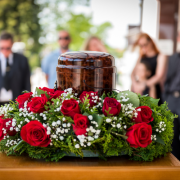A Guide to Key Terms and Considerations
 While cremation has become an increasingly popular choice, navigating the cremation industry can involve unfamiliar terminology and processes. This in-depth guide explores essential terms to empower you to make informed decisions regarding cremation services.
While cremation has become an increasingly popular choice, navigating the cremation industry can involve unfamiliar terminology and processes. This in-depth guide explores essential terms to empower you to make informed decisions regarding cremation services.
The Cremation Process:
- Cremation: The process of reducing human remains to bone fragments through exposure to intense heat, typically exceeding 1400°F (760°C).
- Cremation chamber/retort: The high-temperature furnace used for cremation.
- Cremation container: A combustible container, often made of cardboard or wood, that holds the deceased during cremation.
- Cremated remains/Ashes: The bone fragments remaining after the cremation process is complete. These are typically pulverized into a fine powder.
- Secondary container (urn): A decorative container used to store cremated remains. Urns come in various materials (metal, ceramic, stone) and styles to suit personal preferences.
Regulatory Framework:
- Authorization for cremation: A legal document, typically signed by a next-of-kin or authorized representative, granting permission to cremate the deceased.
- Death certificate: A legal document certifying death. It is typically required before cremation can proceed.
- Medical examiner/coroner: A medical professional who investigates unexpected or suspicious deaths. In some cases, cremation may require authorization from a medical examiner.
Industry Professionals:
- Funeral director/mortician: While not always involved directly, funeral directors can guide families through the cremation process, answer questions, and help navigate legalities.
- Cremation provider/crematory operator: The professional or facility responsible for handling and performing the cremation. They ensure adherence to regulations and ethical standards.
Additional Considerations:
- Witness cremation: In some areas, cremation providers may offer witness cremations, where family members can be present during the cremation process.
- Direct cremation: A basic cremation service without a viewing or funeral ceremony.
- Cremation with memorial service: Families may choose to have a memorial service held after cremation to celebrate the deceased’s life.
- Disposition of cremated remains: Families have various options for cremated remains, including placement in an urn, burial in a cemetery plot, scattering in a designated location, or incorporation into memorial jewelry.
Planning for Cremation:
By understanding these key terms, you can make informed decisions about cremation for yourself or loved ones. Consider discussing your wishes with family members and documenting your preferences in a will or advanced directive. Open communication and advanced planning can ensure your wishes are respected and alleviate burden during a difficult time.









